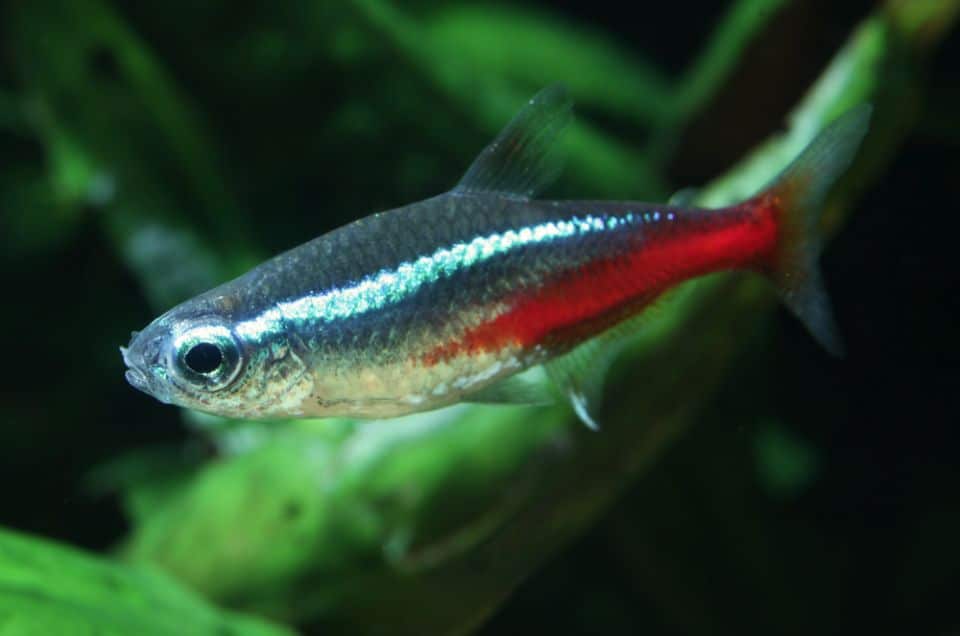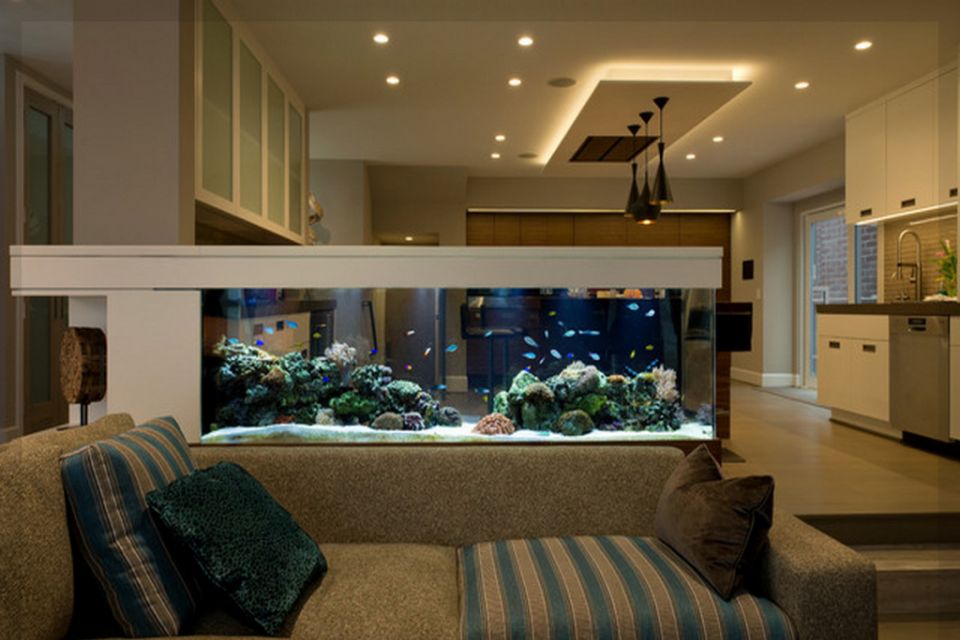Neon tetra in the aquarium: all facts about the lively neon fishes
Next to the cardinal tetra, for which you can information here, neon tetras (Paracheirodon innesi) or also called red neon tetra are probably the most popular ornamental fish in fishkeeping history. Hardly any other aquarium fish can be found so frequently in tanks around the world. No wonder, since the beautiful blue-red colouring of the neon tetra brings life and colour into every aquarium. In addition, its distinctive swarming behaviour is a real splendour that inspires many people. It grows 4cm tall and can therefore already be kept in tanks with a edge to edge length of 20 inches (15-20 gallons). It should swim in groups of at least 10 animals, so that its distinctive swarm behaviour can be seen.
Table of Contents
How do red neon tetras, blue neon and cardinal tetra differ optically?
The neon tetra is apparently not very different from the cardinal tetra in coloring. On closer inspection, however, it can be seen that the red glowing line on the body of the neon tetra only starts at about half of the trunk - approximately at the level of the ventral fin. The turquoise line is identical to the one of the cardinal tetra.
| Cardinal tetra | solid red bar (under the blue bar) |
| neon tetra | half red bar (under the blue bar) |
| blue neon tetra | no red bar (under the blue bar) |

Where do neon tetra occur?
Neon tetras are widespread in South America. They are mainly found in clear water streams of the Peruvian rainforest in the upper Amazon. But also in wide areas of Rio Putumayo over Rio Purus the fish are native and often to be found in large groups.
What water values and temperatures do neon tetra need?
Neon tetras are particularly comfortable with the following water values:
| Temperature: | 20°C-24°C |
| pH-Value: | 5,0 - 7,5 |
| General Hardness: | 2-20 °GH |
Clear water streams of the Amazon are characterised by particularly soft water. Accordingly, the water characteristics of the fishtank provided should not deviate too much from these. The optimum pH value for the neon tetra would be 6.0-6.2, but of course it may be between the above values. The optimum temperature, however, is between 21°C and 23°C. The carbonate hardness (°KH) may lie in identical ranges to the total hardness.
How do you keep neon tetras in the aquarium?
In contrast to cardinal tetra, neon tetras are much better for breeding. Therefore the Neon tetra available in aquaristic shops are mainly offspring and not wild catches. Due to this reason, the neon tetra has already adapted very well to typical US water values. Many of the animals can easily withstand a total hardness of 15-20 °dGH even though they would probably not accept more than 6-10 °dGH in the wild.
Neon tetras are vivid schooling fish that are very easy to keep. They can be held in tanks with a volume of 15-20 gallons or higher if they have an edge length of at least 20-24 inches. In this case, a group of 10 animals is the minimum. However, if one wants to observe the distinct swarm behaviour of the animals in full, they should keep the animals in aquariums with an edge length of 37 inches. If you have already seen a swarm of 25 or more animals in the aquarium and the colours of the animals flash when turning, you know what I am talking about.
Neon tetras can be socialized very well with other small South American ornamental fish. However, it is important to make sure that they can cope with the low water temperatures in which neon tetra feel so comfortable - South American species in particular usually prefer warmer waters between 25°C-27°C. You will find many setting and stocking ideas for the neon tetra in our guide!
Just like the cardinal tetra and other tetra species, the neon tetra prefers dense planting, which consists of fine-grained plants such as the Cabomba aquatica. Ideally, the dense planting should take place in the background, so that enough swimming space is provided for the animals. In contrast to other tetra species, the neon tetra are not only native to the middle of the tank, but are distributed throughout the entire aquarium. The males even cut off territories, therefore bog wood roots and/or stones should be present, which serve the animals as hiding places. The roots are also found in the Amazon, the typical habitat of neon tetra. Dark substrate should be used in the aquarium. This not only makes the colours of the animals appear more intense, but also occurs in the home of the animals. Neon tetra prefer dimmed light. With dimmable LEDs you can make it particularly easy and comfortable for the animals without compromising the other decoration. If there are no dimmable lamps available, you can simply use floating plants, such as the Amazon Frogbit (Limnobium laevigatum).

What does the neon tetra eat?
The neon tetra prefers to eat small water fleas and crustaceans, such as Artemia and Daphnia, which are also widespread in its native waters. This food is taken in the form of live food and frozen food. However, it is also possible to feed the Neontertra commercial dry food without any problems, but it is important to note that it is advantageous for the colourfulness of the fish if you feed live or frozen food, at least at regular intervals. If only dry food is available, I recommend JBL granules. The high-quality dry food contributes to the colouring of the fish and is easier to dose than flake food.
How to breed the neon tetra?
In contrast to the very similar cardinal tetra, for which it is almost impossible to celebrate breeding success, it is much easier to breed the Neon tetra. One should look out for a harmonious couple. (Tip: Male neon tetra can be recognized by a straight turquoise line, they are also smaller than the female animals, which have a curved turquoise line). This is placed in a separate spawning tank which should be filled with very soft water: the pH value must be between 6.0 and 6.2 and the °GH should not exceed 2.0. Mating season takes place in the wild at night or at dawn, so it is very important to completely darken the fishtank during the entire spawning process. Since the neon tetra is a free-spawner that attaches its eggs to the leaves of various fine-grained plants, you should of course offer them to him. After breeding process is complete, the two adult animals are put back into the other fishtank. Shortly after hatching, the young are so small that you have to offer them suitable food: small paramecium, such as Artemia nauplii.
More facts about the neon tetra:
The neon tetra is particularly susceptible to neon disease. The disease is easily detected by discolorations in the area of the animals' tail fins. It causes the backbone of the animals to deform. Decay develops on the fins and the animals lose their entire luminosity. In the end, the disease leads to the death of the animals. It is transmitted by the other neon tetra gnawing on the deceased animal and thus absorbing the pathogens. To prevent the entire swarm from suffering from the disease, the affected animal must be removed from the fishtank as quickly as possible. Now you can only hope that not already other animals of the swarm are affected. If so, these must also be removed.
Conclusion:
The neon tetra is a more widespread aquarium fish, which fascinates thanks to its conspicuous colouring. The Neon tetra is a peaceful "beginner fish", which can simply be socialized with other South American small fish. Its demands on water quality are very modest. He defines territories and therefore demands a decoration rich in structure, which offers him the possiblity to do so. The breeding of the animals is relatively simple.



